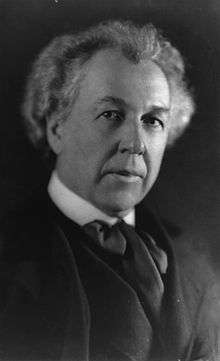Rookery Building
The Rookery Building is a historic office building located at 209 South LaSalle Street in the Chicago Loop. Completed by architects Daniel Burnham and John Wellborn Root of Burnham and Root in 1888, it is considered one of their masterpiece buildings, and was once the location of their offices. The building is 181 feet (55 m) high, twelve stories tall, and is considered the oldest standing high-rise in Chicago.[2] It has a unique style with exterior load-bearing walls and an interior steel frame, which provided a transition between accepted and new building techniques.[2] The lobby was remodeled in 1905 by Frank Lloyd Wright. Beginning in 1989, the lobby was restored to the original Wright design.
Rookery Building | |
Chicago Landmark
| |
 (1891) | |
  | |
| Location | 209 South LaSalle Street Chicago, IL |
|---|---|
| Coordinates | 41°52′44.7″N 87°37′55.6″W |
| Built | 1886 |
| Architect | Burnham & Root; Frank Lloyd Wright; William Drummond; et al. |
| Architectural style | Chicago |
| NRHP reference No. | 70000238 [1] |
| Significant dates | |
| Added to NRHP | April 17, 1970 |
| Designated NHL | May 15, 1975 |
| Designated CL | July 5, 1972 |
The building was designated a Chicago Landmark on July 5, 1972,[3] and was added to the National Register of Historic Places on April 17, 1970 and listed as a National Historic Landmark on May 15, 1975.[4]
Name
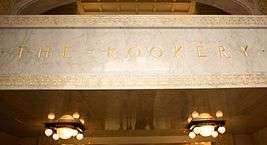
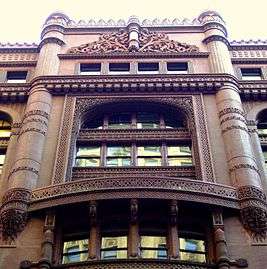
The name of the building is an allusion to the temporary City Hall building that occupied the land before The Rookery.[2] That building was nicknamed the rookery not only in reference to the crows and pigeons that flocked to its exterior, but also because of the alleged shady politicians it housed (given the rook's perceived reputation for acquisitiveness).[2][5][6]
After the Great Chicago Fire a quickly constructed building was used as an interim City Hall at this location (LaSalle and Adams) built around a large water tank that had survived the fire. However, pigeons became such a nuisance that a complaining citizen began referring to the building as "a rookery", a term the press quickly adopted. Although several names were considered when a new structure on the site was proposed, "the Rookery" won out.[7]
Construction
Burnham & Root
The Rookery was built in 1888 by the architectural partnership of Daniel H. Burnham and John Wellborn Root, known as Burnham and Root. In the architectural boom that followed the Great Chicago Fire, architects in what would become known as the Chicago School of commercial architecture competed with each other to create the world's first true skyscrapers. By mixing modern building techniques, such as metal framing, fireproofing, elevators and plate glass, together with traditional ones, such as brick facades and elaborate ornamentation, Burnham and Root sought to create a bold architectural statement. At the same time, they intended their buildings to be commercially successful.[5] This building is one of the few results of their partnership that is still standing.[8]
As the master artisan, Root drew upon a variety of influences in designing the interior and exterior spaces, including Moorish, Byzantine, Venetian and Romanesque motifs.[5] He also provided the architectural innovations that brought together many contemporary cutting edge building techniques. Of particular note was a "floating" foundation—a reinforced concrete slab that provided the building's weight with a solid platform atop Chicago's notoriously swampy soil.[5] The term for the type of foundation that Root designed is grillage foundation, a foundation where iron rails and the structural beams are combined in a crisscross pattern and encased in concrete to support the building's immense weight without heavy foundation stones.[2] This construction is particularly useful when structural loads are high compared to the natural bearing capacity of the soil.[9]

Light court
Making prodigious use of light and ornamentation, Root and Burnham designed a central light court to serve as the focal point for the entire building and provide daylight to interior offices. Rising two stories, the light court received immediate critical acclaim. "There is nothing bolder, more original, or more inspiring in modern civic architecture than its glass-covered court", wrote Eastern critic Henry Van Brunt.[5] At a time when Chicago's bold experiment in architecture was looking eastward for affirmation, this was welcome praise.[5] The light court provides natural illumination for the interior offices.[7][8]
Frank Lloyd Wright was a young architectural assistant working with Adler and Sullivan at the time the Rookery was built in 1888. Architect Daniel Burnham was a friend of Wright patron Edward C. Waller. Waller managed the Rookery; Wright had his offices in the building in 1898–1899. In 1905 Wright received the commission to redesign the lobby in the building; at the time considered the grandest in Chicago.[10] Wright's work on the Rookery recast the entryway in his Prairie style and added a sense of modernity through his simple but effective lighting design.[10] Wright's work on the Rookery is his only work on any building within the downtown cityscape.[10]
Among Wright's most significant alterations was the addition of white marble with Persian-style ornamentation. The marble and decorative details added a sense of luxury to the lobby's steel-laden interior, marked by Burnham and Root's skeletal metal ribbing.[10] The entire interior space is bright and open. A double set of curving, heavily ornamented stairs wind upward from the lobby's second floor into the building's interior. A wrap-around balcony on the second floor enhances the feeling of being within the interior of a "clockwork."[10] The Wright remodel opened the building up to more of the available light.[10]
Load bearing walls and steel structure
The red marble, terra cotta and brick facade of the building is a combination of Roman Revival and Queen Anne styles that embraced Richardsonian Romanesque architecture.[8][11] The building, which is a combination of iron framing and masonry bearing walls,[12] marked a transition from masonry load-bearing structures to steel skeleton load-bearing structures.[3] In fact, the Landmarks Commission citation commends "development of the skeleton structural frame using cast iron columns, wrought iron spandrel beams, and steel beams to support party walls and interior floors".[7] Aside from the first two floors of metal-framed perimeter walls, the walls are all masonry.[2] The building is known for its semi-circular staircase west of the light court.[2]
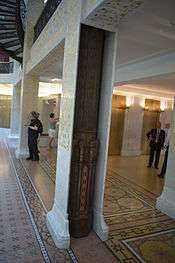
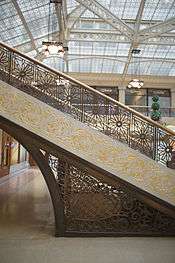
Renovations
While much of the Loop's 19th-century architecture has been lost to demolition and redevelopment, the Rookery has been spared this fate through a series of well executed renovations. The building remains a commercially successful rental office building, as it was when it was first built.[5]
Beginning in the early 20th century, the building underwent three major renovations. In the first, from 1905 to 1907, Frank Lloyd Wright was retained to remake the interior spaces. In keeping with contemporary tastes, Wright's design covered Root's elaborate wrought iron finishes with white carved Carrara marble surfaces. Wright was highly regarded by the public at this point, and his changes brought enhanced status to the building, making the Rookery one of the most sought after buildings of Chicago.[5] Some of Wright's other changes included incorporating simplified ironwork and adding his trademark style planters and light fixtures.[2]
The second renovation, completed August 24, 1931 by former Wright assistant William Drummond, modernized many of the interior elements, including new elevators, and brought period touches to the building, such as Art Deco detailing.[10] The third renovation, in 1992, brought the building back to much of its original splendor, reopening the light court ceiling after it had been covered over to protect against leaks.[5]
After their purchase of the Rookery in October 2007, the new owners announced plans for an extensive renovation of the building's common areas.[13] Award-winning state-of-the-art LED lighting was added to the exterior of the building in 2011 to highlight the architectural features and in 2014 The Rookery achieved LEED Gold certification. In 2015 the restrooms were upgraded to marble-rich, five-star quality as well as a full-featured bike room was added. Also a full elevator modernization was accomplished, inclusive of Destination Dispatch and visitor system in 2017.[14]
Tenants
Burnham & Root had their offices at the Rookery for a while upon its completion, and at one time Frank Lloyd Wright had an office in the building as well.[2] Current tenants include US Bank, Brooks Brothers, Perkins Eastman and Interactive Brokers Group.
Current ownership
The building was purchased in October 2007 for $73 million by an investment group controlled by a European family, and advised by Zeb Bradford of Metzler North America Corp. The seller was Broadway Real Estate Partners of New York, which had bought the Rookery for $56 million in April 2006. BREP was reported to have increased occupancy of the building's 281,000 sq ft (26,100 m2) from 80% in January 2007 to 96% at the time of the sale.[13]
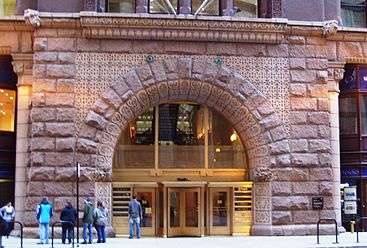
Visiting
The Frank Lloyd Wright Trust offers tours inside Mondays through Fridays.[15] Inside Chicago Walking Tours offers daily walking tours that explore the interior of the Rookery in addition to many other historic Chicago buildings.[16] The Chicago Architecture Foundation also provides tours approximately twice a month.[17]
In popular culture
- The Rookery Building was featured in the film Home Alone 2: Lost in New York, in which the exterior and one of the lower levels were modeled as the toy store Duncan's Toy Chest.[18]
- The Rookery was used by Frank Norris in his novel The Pit as the site of the office of fictional financial speculator Curtis Jadwin.[2]
- The Rookery was featured prominently in the 1987 film The Untouchables as the police headquarters of Eliot Ness.[19]
See also
- Early skyscrapers
- J.H.C. Petersen's Sons' Store, a small-scale version of the building located in Davenport, Iowa.
References
Notes
- "National Register Information System". National Register of Historic Places. National Park Service. March 15, 2006.
- "The Rookery, Chicago". Emporis Buildings. 2007. Retrieved May 15, 2007.
- "Rookery Building". City of Chicago Department of Planning and Development, Landmarks Division. 2003. Archived from the original on September 25, 2007. Retrieved May 15, 2007.
- "Rookery Building". National Park Service. Archived from the original on June 5, 2011. Retrieved July 4, 2007.
- Pridmore, Jay; Hedrich Blessing (2007). The Rookery. Pomegranate Communications. ISBN 0-7649-2306-4.
- "Rookery Building". Explore Chicago. City of Chicago. Archived from the original on January 26, 2012. Retrieved November 27, 2011.
- "The Rookery". Pat Sabin. Archived from the original on July 1, 2007. Retrieved May 24, 2007.
- "Chicago - The Rookery". PlanetWare Inc. 2007. Retrieved May 24, 2007.
- "Dictionary of Interior Designing". Serene Interiors. 2006. Retrieved May 26, 2007.
- O'Gorman, Thomas J., Frank Lloyd Wright's Chicago, Thunder Bay Press, San Diego: 2004, pp.189–193, (ISBN 1592231276).
- "Architecture: The First Chicago School". Electronic Encyclopedia of Chicago. Chicago Historical Society. 2005. Retrieved May 26, 2007.
- "Rookery Building, 1905". Electronic Encyclopedia of Chicago. Chicago Historical Society. 2005. Retrieved May 26, 2007.
- Diesenhouse, Susan (October 17, 2007). "Rookery bought by European investors". Chicago Tribune. pp. 2.1–2.2. Retrieved November 1, 2007.
- Sudo, Chuck (November 21, 2017). "Behind The Scenes of The Rookery's New Features". Bisnow.com. Retrieved September 13, 2017.
- "Free Tours of Chicago’s Rookery Building" on the Free Things to Do in Chicago website (March 28, 2011)
- "The World Within: Inside the Dazzling Interiors of the Loop"
- "Rookery Building" Archived September 18, 2011, at the Wayback Machine on the Chicago Architecture Foundation website
- "Home Alone 2: Lost in New York Filming Locations". Movie Locations Guide.
- Kerch, Steve (March 28, 1993). "Leasing Goes Gangbusters At Historic Rookery, A Set For `Untouchables'". Chicago Tribune. Retrieved September 7, 2013.
- Storrer, William Allin. The Frank Lloyd Wright Companion. University Of Chicago Press, 2006, ISBN 0-226-77621-2 (S.113)
External links
| Wikimedia Commons has media related to Rookery Building. |
- Official Rookery Building website
- Rookery Building — City of Chicago Dept. of Planning and Development webpage on the building.
- Emporis Buildings: The Rookery
- A National Register of Historic Places Travel Itinerary of Chicago
- Tour the Rookery with Inside Chicago Walking Tours
- Chicago Architecture Foundation's webpage about the building
- Picture of the "Old Rookery" Water Tower and City Hall after the Great Chicago Fire
